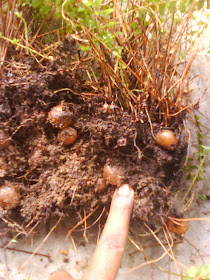
I got this one from my friend, who was clearing his garden and passed all his excess plants to me. Actually this one was huge and was placed in one pot, I had split them and placed them in several pots. After some time of giving plants to few friends and here and there, it was about time to re-plant the overgrown root (more roots then soil found in one pot)
Well for the record, this one is known as Drawf Petticoat Fern. (Nepthrolepis Cordifolia)It has the forked split fronds at the tips, more like a turkey tail shaped ferns.
The story goes that one day when I was digging this ferns and lo and behold I found lots & lots of this root balls, they are actually known as rhizome. I guess its a water storage for this plant. Also notice that there are fine little runners at the edges of this root balls. I guess it can be propagated using this tubers.
Its considered an invasive plant. In my point of view, what you would say when it was invasion took for centuries? Would you considered it as native, well that's the case here, no one knows whether they were foreign or local material. What can be said is that its so common here that "old world" gardeners will laugh if someone purchase this one and considered it an ornament.
It took me sometime to convince my mum and my mother in law that Boston Ferns do have ornamental value and often sold in supermakets and nurseries as garden plants. (since both of them weed out these ferns in their gardens)








I'm trying to find a petticoat fern to use in hanging basket. None to be found in all nursery's I visit.
ReplyDeleteshould i leave the root balls attached? i am cutting off the dead stems of my fern to replant them in another container. when i saw them, and mind are green more so than brown i panicked and quarantined it. thanks for the heads up!
ReplyDeleteYou can leave the root balls as they serve as food reserve for the ferns. In most cases a baby plant can appear from the root ball itself but it is not 100% guaranteed.
Deletewhat is the difference between the green root balls and the brown ones?
ReplyDeleteI guess there is no difference.
DeleteMost likely the green ones are still small and young whereas the brown ones must be matured.
I don't know much about ferns - I have a petticoat fern that I've had for a few years - it came in a 9" hanging basket and now occupies a 18" pot. Every once in a while I notice furry vine-like shoots coming out of the soil. I have one that has grown quite long and now has started a new fern shoot - can I start this as a new fern?
ReplyDeleteYes those furry vine-like shoots are runners for the plant to start a new colony.
DeleteYou need to let them establish them.
Get another hanging pot with soil and place these runners on them.
They will start rooting and produce little plant-lets along those runners.
some one threw away pieces of fern with roots and balls and i scooped them up. do i let them rest and then pot or pot right away
ReplyDelete